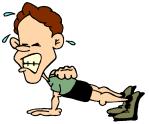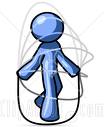







Wildlife walk

Fitness Charts
Meeting desirable fitness goals requires exercising outside of school due to the limited time often allocated to physical education class. Exercising outside of school gives students a chance to set and monitor personal goals, consistent with authentic assessment. With this in mind, the following guidelines provide teachers with criteria for constructing fitness charts, which represent just one tool for pursuing fitness goals. Along with the guidelines, several examples of fitness charts may be downloaded and used with classes. Examples target the elementary and middle school levels, since high school students are well-equipped to construct their own charts. Specific grade levels are not indicated on the charts to afford teachers the most flexibility possible. Naturally, any aspect of a chart may be modified to tailor it better to a particular grade level or class.
Guidelines
Inclusivity
Construct fitness charts so any student may record progress, regardless of experience or ability. Options for students include performing a given exercise or activity in a different manner, for a different number of times, or for a shorter or longer duration. Push-ups, for instance, can be done from a traditional push-up position, a more difficult position with the feet elevated slightly, or an easier position with the knees on the floor. Naturally, students may be challenged to increase the number or duration of an exercise over time. In so doing, the difference between various options should become greater, rather than remain the same.
Measurement
Set up measurement parameters to monitor progress in the most useful way possible. Measurement needs to be accurate and valid, while still being manageable. Pull-ups, for instance, are a crude measurement of upper arm strength, since the strength required to advance in number (particularly at the lower performance levels) is so great. For strength-related activities, allow for a different number of repetitions. For aerobic exercise, distance may be measured, but time is the single best parameter.
Time frame
Establish a time frame of approximately 14-15 days on fitness charts. This represents the minimum time required to incorporate a habit into one's lifestyle. Results may either be recorded everyday for two weeks, or on alternate days for a month. Nutritional practices are best recorded every day for the sake of consistency. Strength development is best recorded on alternate days to minimize fatigue. Aerobic activity, on the other hand, could be recorded every day or on alternate days. Since charts represent a relatively short time frame, students could complete the same chart more than once.
Motivation
Although students are motivated in different ways and to different degrees (and some seemingly not at all), motivational elements can potentially enhance student interest in using fitness charts. Interest may be generated by including pictures on charts of either well known or generic people or cartoon characters. Interest may also be influenced by using a creative title and/or slogan, or unusual means of recording information. Titles that incorporate rhyming, alliteration, or a play on words are more motivating than mundane ideas. As an example, "rubber band robot" sounds more interesting than "flexibility chart." Yet another way to motivate students is to combine the progress of individual students toward a class goal. Such goals can capitalize on well known events or geographical features that commonly receive public attention. An example of an event would be to combine mileage to figuratively complete the Tour de France. (See example below) An example of a geographical feature could be to have a class figuratively climb Mount Everest.
Examples
|
Power-packed
push-ups |
 |
 |
Sailor's
secret |
 |
|
| Keep cool |  |
Be like bulky |  |
Exercise rounds |  |
 |
 |
Wildlife walk |
 |
© Steven A. Henkel, 2/10